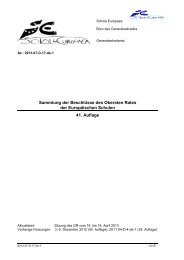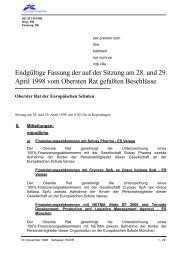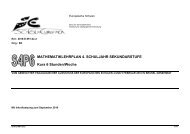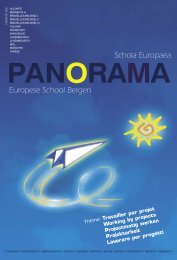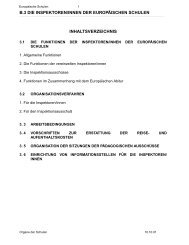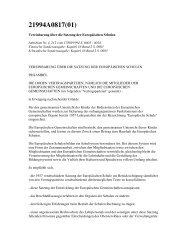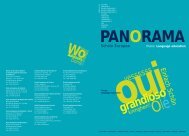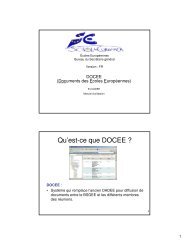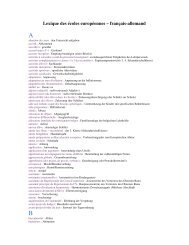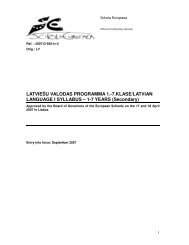External Evaluation of the European Baccalaureate (Annexes)
External Evaluation of the European Baccalaureate (Annexes)
External Evaluation of the European Baccalaureate (Annexes)
Create successful ePaper yourself
Turn your PDF publications into a flip-book with our unique Google optimized e-Paper software.
47<br />
• Condition for existence <strong>of</strong> a unique<br />
solution, no solution and an infinity <strong>of</strong><br />
solutions<br />
• Approx 12 hours teaching time<br />
The table above lists <strong>the</strong> core content for each Programme <strong>of</strong> Study (PoS). It does not include <strong>the</strong> option<br />
syllabus for IB which requires ano<strong>the</strong>r 40 hours <strong>of</strong> teaching time. If <strong>the</strong> Statistics option is selected, <strong>the</strong>re<br />
is fur<strong>the</strong>r overlap between <strong>the</strong> two programmes <strong>of</strong> study, but overall, <strong>the</strong> Stats option includes additional<br />
topics not listed above.<br />
COMPARISONS OF THE TWO PROGRAMMES OF STUDY<br />
Working through <strong>the</strong> topics as listed against <strong>the</strong> EB PoS<br />
• Complex numbers - both take <strong>the</strong> topic to a similar level <strong>of</strong> difficulty, interestingly <strong>the</strong> EB makes<br />
mention <strong>of</strong> trigonometric form, but nowhere else in <strong>the</strong> diploma, is trigonometry mentioned as a<br />
topic for study. The IB allows approximately 22 hours <strong>of</strong> study allocated to <strong>the</strong> teaching <strong>of</strong><br />
trigonometry including trigonometry within <strong>the</strong> complex number topic.<br />
• Functions- <strong>the</strong> EB gives a greater focus to <strong>the</strong> teaching <strong>of</strong> Functions. This may reflect <strong>the</strong> greater<br />
emphasis on <strong>the</strong> teaching <strong>of</strong> functions up to <strong>the</strong> age <strong>of</strong> 16 in some <strong>European</strong> Countries. The EB<br />
places greeter emphasis on <strong>the</strong> algebraic form <strong>of</strong> functions whereas <strong>the</strong> IB focuses on <strong>the</strong><br />
graphical solutions <strong>of</strong> functions, with a big emphasis on <strong>the</strong> use <strong>of</strong> technology. Questions are<br />
frequently set which require <strong>the</strong> use <strong>of</strong> Graphical Display Calculators (GDC). It is extremely<br />
difficult to follow <strong>the</strong> SL Diploma at IB, without owning and understanding how to use a GDC. The<br />
EB does not mention use <strong>of</strong> GDC.<br />
• Differentiation and Integration are treated similarly as topics, with a similar level <strong>of</strong> difficulty. The<br />
IB places a greater emphasis on <strong>the</strong> use <strong>of</strong> Calculus to solve practical problems, <strong>the</strong> EB tends to<br />
stay with a more abstract emphasis to <strong>the</strong> PoS<br />
• Vectors- <strong>the</strong> EB places a greater emphasis on <strong>the</strong> teaching <strong>of</strong> Vectors, <strong>the</strong> level <strong>of</strong> difficulty<br />
required is greater than <strong>the</strong> IB<br />
• The geometry <strong>of</strong> a sphere is studied as a separate subject in <strong>the</strong> EB PoS, it is not mentioned in<br />
<strong>the</strong> IB PoS<br />
• Probability and Statistics-, <strong>the</strong> EB places a greater focus on <strong>the</strong>se topics when compared to <strong>the</strong><br />
IB, unless <strong>the</strong> optional unit studied at IB, is in fact <strong>the</strong> Statistics option. Within <strong>the</strong> topic, <strong>the</strong> IB<br />
places a greeter emphasis on probability, <strong>the</strong> EB looks at more statistical techniques and to a<br />
greater degree <strong>of</strong> difficulty, unless again <strong>the</strong> option studied at IB is Statistics, in which case, <strong>the</strong> IB<br />
PoS takes students to a more advanced level <strong>of</strong> statistics.<br />
• Algebra- <strong>the</strong> EB makes no mention <strong>of</strong> algebraic topics involving sequences and series. It makes<br />
no mention <strong>of</strong> logarithms and use <strong>of</strong> different bases and <strong>the</strong> binomial expansion. The IB allows 20<br />
hours <strong>of</strong> teaching time for <strong>the</strong>se topics.<br />
• Circular functions and trigonometry-<strong>the</strong> EB makes only one reference to trigonometry as part <strong>of</strong><br />
<strong>the</strong> programme for <strong>the</strong> teaching <strong>of</strong> complex numbers. The IB allows for 22 hours <strong>of</strong> teaching time<br />
on trigonometry and <strong>the</strong> circular functions<br />
• Matrices- this topic is only covered by <strong>the</strong> IB, <strong>the</strong>re is no mention <strong>of</strong> <strong>the</strong> topic on <strong>the</strong> EB syllabus.<br />
Only 12 hours is allocated to <strong>the</strong> teaching <strong>of</strong> this topic.<br />
To summarise, in general, where <strong>the</strong>re are common elements to <strong>the</strong> PoS, <strong>the</strong> topics are studied to a<br />
similar degree <strong>of</strong> difficulty. The EB would appear to be a more ‘skills’ focused syllabus; it requires<br />
knowledge <strong>of</strong> fewer areas <strong>of</strong> maths. The year 7 syllabus is <strong>the</strong> main focus <strong>of</strong> <strong>the</strong> final exam with only some<br />
<strong>of</strong> <strong>the</strong> year 6 work assessed. The IB PoS would appear to assess a greater knowledge <strong>of</strong> different aspects<br />
<strong>of</strong> Maths and not only does it test skills, it also tests for understanding with pro<strong>of</strong> being mentioned as an<br />
explicit part <strong>of</strong> <strong>the</strong> core syllabus. The balance on <strong>the</strong> IB PoS is better across <strong>the</strong> main strands, Number,<br />
Algebra, Geometry and Probability/Statistics. The EB does not focus on <strong>the</strong> teaching <strong>of</strong> advanced number<br />
topics as such, with <strong>the</strong> emphasis on <strong>the</strong> teaching <strong>of</strong> abstract concepts, whereas <strong>the</strong> IB includes <strong>the</strong><br />
teaching <strong>of</strong> advanced number work in a real context. The coverage <strong>of</strong> Geometry is also limited to vectors



